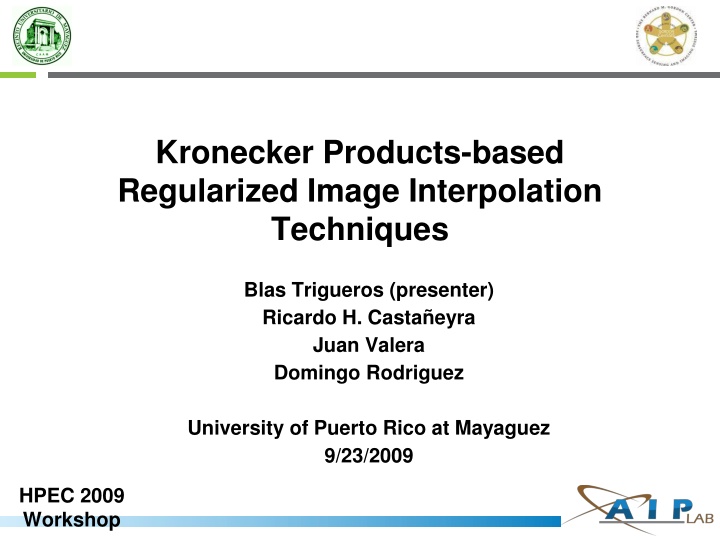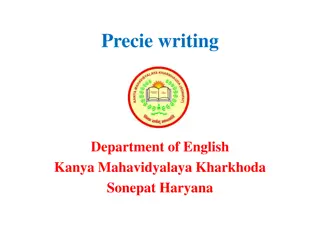
Kronecker Products-based Regularized Image Interpolation Techniques
Enhance your understanding of image interpolation with the Kronecker products-based regularized technique, presenting a parallel implementation for high-resolution image restoration from low-resolution noisy images. Explore the problem formulation, implementation model, and performance results of this algorithm, utilizing SVD and Kronecker products to reduce computational costs effectively.
Download Presentation

Please find below an Image/Link to download the presentation.
The content on the website is provided AS IS for your information and personal use only. It may not be sold, licensed, or shared on other websites without obtaining consent from the author. If you encounter any issues during the download, it is possible that the publisher has removed the file from their server.
You are allowed to download the files provided on this website for personal or commercial use, subject to the condition that they are used lawfully. All files are the property of their respective owners.
The content on the website is provided AS IS for your information and personal use only. It may not be sold, licensed, or shared on other websites without obtaining consent from the author.
E N D
Presentation Transcript
Kronecker Products-based Regularized Image Interpolation Techniques Blas Trigueros (presenter) Ricardo H. Casta eyra Juan Valera Domingo Rodriguez University of Puerto Rico at Mayaguez 9/23/2009 HPEC 2009 Workshop
Problem Formulation In this work, we present a parallel implementation of an image interpolation algorithm based on the Tikhonov regularization technique, for the restoration of a (high resolution) HR image from a (low resolution) LR noisy image. Previous work: Direct interpolation (cubic spline, adaptive spline ) Regularization functional-based interpolation [1]. Discrete Cosine Transform (DCT) based techniques [2]. Solution approach: Parallel implementation performed using pMATLAB based on the regularized interpolation technique proposed by Li Chen et al. [3]. Data parallelism is employed to reduce execution time by partitioning the image into overlapping subimages. Overlapping technique is introduced to avoid edge distortions.
Implementation Model f: high-resolution image g: low-resolution image D: decimation matrix H: low-pass filter (blurring) n: additive noise Observation model: SVD: This algorithm takes advantage of SVD and Kronecker products to reduce the computational cost of the regularized solution. But the SVD computation grows as O(N3), prohibitive for large matrices. Parallel Implementation: In our implementation of the algorithm, the image is partitioned into subimages, and each processor computes a portion of the final result. Each processor Pi computes an SVD of dimension: Np 1 kN N Overlapping zone NxN: dimension of the LR image k: decimation factor Np: number of processors
Performance Results Execution time (s) MATLAB serial 0.0347 0.3397 1.96 18.62 211 2471 13864 Execution time (s) pMATLAB HR image size 256 x 256 512 x 512 1024 x 1024 2048 x 2048 4096 x 4096 8192 x 8192 16384 x 16384 0.0067 0.0399 0.2480 1.85 20.44 219 1982 (a) Figure 1: (b) (a) LR image, (b) HR image. Table 1: Execution time results of the interpolation algorithm in MATLAB and pMATLAB (4 processors, 2x2 mapping) Computation time is reduced by using distributed arrays on pMATLAB for the SVD operation. References: [1] Julie Kamm and James G. Nagy, Kronecker product and SVD approximations in image restoration, Linear Algebra and its Applications, Vol. 284, pp. 177-192, Jan 1998 [2] Yoshinori Abe, Youji Iuguni, Image restoration from a downsampled image by using DCT, Signal Processing, 87, pp. 2370-2380, Mar 2007 [3] Li Chen and Kim-Hui Yap, Regularized Interpolation Using Kronecker Product for Still Images, IEEE International Conference on Image Processing, Vol. 2, pp. 1014-17, Sep 2005.




















